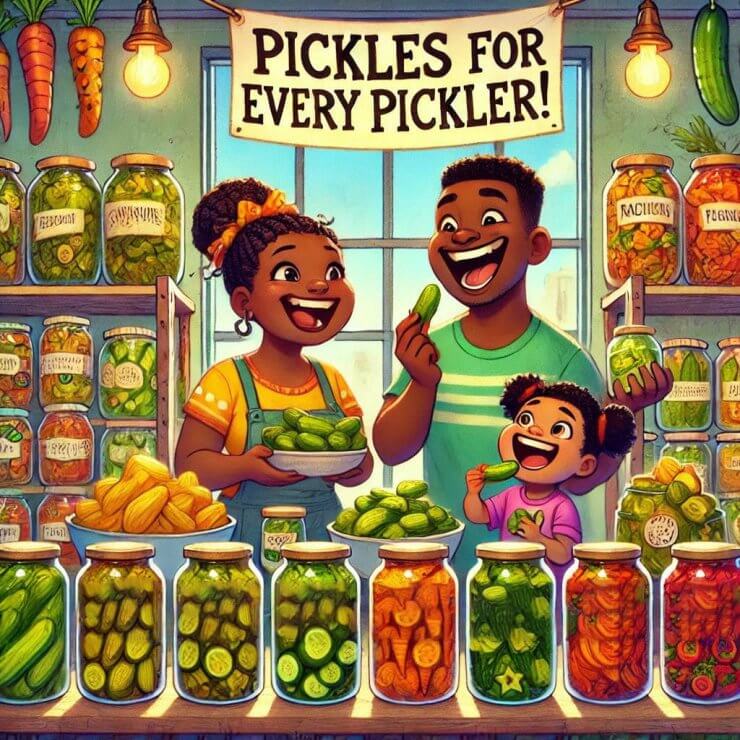Read by Michael Flamel

In my cozy town of Plymouth, nestled among bakeries and antique shops, there exists a store that proudly dedicates itself to all things pickled. I’m talking about cucumbers, of course, but also carrots, radishes, cabbage, and, perhaps unexpectedly, spicy mango and rosemary-infused lemons! The Pretentious Pickle isn’t just a shop; it’s a testament to America’s latest love affair with the briny and the bold. Yes, the pickle craze has taken root across the nation, and like any good gardening reporter, I had to dive in—preferably with a big crunchy bite.
A Brief History of Pickling: From Preservation to Passion
Pickling has roots that go back to the ancient Mesopotamians, who used salt brine to preserve precious vegetables, meat, and fish as early as 2400 BCE. The practice was valued for extending the life of food, a necessity before refrigeration. Pickling traveled through the centuries, across Egypt, Europe, and eventually to America. The first settlers brought pickling skills to the New World, transforming not only the way we preserve food but the flavors we enjoy today.
Fast-forward a few hundred years, and America’s pickle scene is a testament to culinary creativity. What began as a means of food preservation has morphed into an art form, complete with artisanal ingredients, craft techniques, and a whole lot of spice. Now, the American palate craves pickles as an accompaniment, a snack, and even a standalone delicacy. Today, it’s estimated that Americans consume more than nine pounds of pickles per person per year! That’s a lot of crunch.
Pickling at Home: A Garden Trend with Benefits
The rise in pickle consumption isn’t limited to specialty shops. Home gardeners are diving in, preserving everything from Summer zucchini to Winter radishes. Pickling provides a way to savor garden freshness long after the growing season ends, and even novice gardeners are finding it easier than ever. With a bounty of vegetables, a few basic ingredients, and a couple of jars, anyone can become a backyard pickler.
And the benefits of pickling extend beyond the thrill of preservation. Pickled vegetables retain their core nutritional goodness—meaning you get a concentrated dose of vitamins, minerals, and fiber with every crunch. Plus, thanks to the fermentation process, pickles offer gut-health benefits by supporting a healthy microbiome. Fermented foods like pickles introduce probiotics that can boost digestion and support immune function. So, if you’re on a mission to grow and pickle at home, you’ll be helping your gut—and your tastebuds—stay happy.
Fun Facts About Pickles to Ponder
Did you know pickles have a rich history as a snack for soldiers? The practice began during the Civil War, when they were handed out to troops for both sustenance and hydration. Today, they’re popular with athletes as a source of electrolytes, thanks to their salty brine.
And as a bit of trivia, Cleopatra is rumored to have attributed her legendary beauty to a diet rich in pickles, while the likes of Julius Caesar used them to fuel his army, believing they made his soldiers stronger. Pickles aren’t just crunchy—they’re historic!
The Easy Route: Refrigerator Pickles
If pickling sounds like a major project, fear not! Our fellow food writer, Amanda, recently shared a fabulous guide on making refrigerator pickles—an easy, fast method that skips the fermentation wait. It’s so straightforward, even I can make a batch in no time! Just a bit of slicing, a quick brine, and a few hours in the fridge. Check out Amanda’s article for the full recipe; you’ll be crunching on homemade pickles before you know it.
So, here’s to the next great trend in American snacking! Pickling may have ancient roots, but it’s tastier—and healthier—than ever. This is Don Nicholas, your intrepid gardening reporter, bringing you all the news that’s fit to pickle. Thank you to the folks at The Economist for putting this tasty trend on our radar. Let’s all keep our gardens growing and our brine bubbling! ❖


 Previous
Previous


